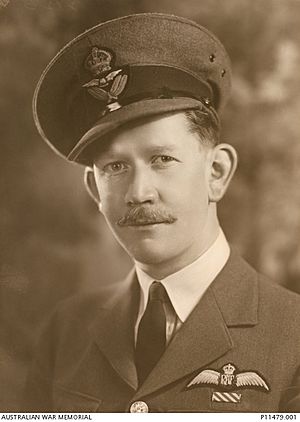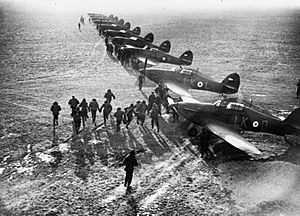John Cock (RAF officer) facts for kids
Quick facts for kids
John Reynolds Cock
|
|
|---|---|
 |
|
| Born | 3 March 1918 Renmark, South Australia, Australia |
| Died | 20 August 1988 (aged 70) Tewantin, Queensland, Australia |
| Allegiance | Australia |
| Service/ |
Royal Air Force |
| Rank | Squadron Leader |
| Unit | No. 3 Squadron No. 222 Squadron No. 453 Squadron No. 87 Squadron |
| Commands held | No. 72 Squadron |
| Battles/wars | Second World War |
| Awards | Distinguished Flying Cross |
John Reynolds Cock was an amazing Australian pilot during the Second World War. He was part of the Royal Air Force (RAF). He was known as a "flying ace" because he shot down at least ten enemy planes!
John was born in South Australia in 1918. He joined the RAF in March 1938. After finishing his flight training, he became a pilot with No. 87 Squadron. He flew Hawker Hurricane fighter planes in the Battle of France and the Battle of Britain. During these battles, he achieved many aerial victories.
Later, he worked as a flight instructor. He then returned to flying missions with No. 453 Squadron. In 1943, he went to Darwin, Australia, for a few months. After that, he returned to Europe. He flew Hawker Tempest fighters with No. 3 Squadron. He spent the last months of the war in East Africa.
After the war, John stayed in the RAF for a while. He even commanded No. 72 Squadron in Austria. He left the RAF in 1948 and went back to Australia. He passed away in 1988.
Contents
Early Life and Joining the RAF
John Reynolds Cock was born on March 3, 1918. His hometown was Renmark, Australia. His father was an engineer. John went to Renmark High School and was a great swimmer.
He loved flying from a young age. He started flying lessons when he was just 16. By 1938, he had already flown for almost 50 hours! He then decided to join the Royal Air Force (RAF). He applied for a special short-term officer role.
John traveled to England for his flight training. He passed the first part of his training. On May 7, he officially became a pilot officer. He finished his training in December. Then, he joined No. 87 Squadron. This squadron was based at Debden. They flew Hawker Hurricane fighter planes. By March 1939, his pilot officer status was confirmed.
World War II Adventures
When the Second World War began, John's squadron was sent to France. They were part of the British Expeditionary Force. During a quiet period called the Phoney War, they patrolled the front lines. They also tried to stop German planes. On April 10, John got his first confirmed victory. He shot down a German Heinkel He 111 bomber over the sea.
Battle of France Missions
The fighting became much more intense on May 10, when the Battle of France started. John was very busy! On that day, he damaged two German bombers and destroyed a Junkers Ju 88 bomber. Two days later, he shot down another Heinkel He 111 near a bridge. On May 14, he destroyed a Messerschmitt Bf 109 fighter plane.
He claimed to have destroyed another Ju 88 on May 16, but this couldn't be confirmed. On May 18, he shot down a Junkers Ju 87 dive bomber and damaged another. The next day, he and three other pilots shared in destroying a German reconnaissance plane. His squadron returned to England on May 22. They had been in intense air battles for 12 days.
Heroism in the Battle of Britain
Back in England, John's squadron got new equipment. They became ready for action again on June 21. In July, they moved to Exeter. Their job was to defend the south-west coast of England during the Battle of Britain. On July 10, John damaged a German bomber.
On the night of July 26, John shot down a Heinkel He 111 bomber. This was during a night fighting mission.
On August 11, John's squadron was called to stop German bombers. These bombers had just attacked fuel tanks at Portland. John destroyed a Bf 109 fighter plane while chasing the bombers. He then destroyed one Ju 88 bomber and probably destroyed another. He also claimed a Bf 110 as a probable victory. However, his Hurricane plane was hit by enemy fire.
John was slightly wounded in the shoulder. He had to bail out of his plane. It was a bit tricky to get out! As he floated down with his parachute, a Bf 109 fired at him. Luckily, he wasn't hurt, but some of his parachute cords were cut. Another RAF fighter chased away the Bf 109. John landed in the English Channel. He took off his boots and trousers and swam to shore. After this exciting event, he was given a month of leave to rest.
When John returned to his squadron the next month, the Germans were attacking London. They were also targeting aircraft factories in southern England. John had been promoted to flying officer. On September 26, he destroyed a Ju 88 and damaged a Bf 109. Two days later, he shot down another Ju 88. He also probably destroyed a Bf 109. During the fight with the Ju 88, he almost crashed into it!
In early October, the Germans started using Bf 109s as fighter-bombers. These planes made fast attacks on targets in southern England. On October 10, John probably destroyed a Bf 109 over Portland. This was his last aerial victory.
On October 24, John was in a collision. His Hurricane's engine failed. Another Hurricane flying behind him crashed into the back of his plane. John managed to land safely, but the other pilot sadly died. The very next day, John was given the Distinguished Flying Cross (DFC). This award is for bravery in air combat. The official announcement said:
This officer has destroyed seven enemy aircraft. In August, 1940, when in action against a large formation of enemy aircraft, he attacked and destroyed a Junkers 88. During this combat he was attacked from below and his aircraft caught fire. Though wounded, he escaped by parachute and fell into the sea, but saved himself by swimming ashore. Flying Officer Cock has shown magnificent courage and initiative against overwhelming odds.
Later War Service
In November, John's squadron moved to Colerne. They started focusing on night fighting. The next month, John was sent to train as a flight instructor. He taught new pilots until August 1941. Soon after, he was promoted to flight lieutenant.
In July 1942, he returned to flying missions. He joined No. 453 Squadron. This was a new Australian fighter squadron. They flew Supermarine Spitfire fighters. Their job was to patrol convoys and intercept enemy planes.
In November, John was sent to Australia. He was based in Sydney at first. In May 1943, he joined No. 1 Fighter Wing in Darwin. This unit protected northern Australia from Japanese air attacks. He helped improve the shooting skills of the fighter pilots. He also flew Spitfires with a British unit there. In early 1944, he was promoted to temporary squadron leader. Later in 1944, he returned to England. In September, he joined No. 3 Squadron. This squadron flew Hawker Tempest fighters. They escorted bombers and supported ground troops.
From April to August 1945, John was in Khartoum, East Africa. He tested a new type of Hawker Tempest plane. By the end of the war, he was credited with destroying 10 German aircraft. He also shared in shooting down another. He had one unconfirmed kill, four probable kills, and five damaged enemy planes.
Life After the War
In February 1946, John became the commander of No. 72 Squadron. His squadron was part of the forces in Austria after the war. They flew Spitfire planes and patrolled the border. As Britain returned to peacetime, the squadron was disbanded in December. John's time with the RAF ended in January 1948.
John returned to Australia. He settled in Queensland. There, he started and ran a supermarket for many years. He retired in 1983. In the same year, parts of his Hurricane plane were found in the sea off Portland. This was the plane he had bailed out of in 1940! Aviation experts recovered the parts. John even traveled to England for the occasion.
John Reynolds Cock passed away in Tewantin, Queensland, on August 20, 1988. His daughter later sold his medals. Besides the DFC, he also had the 1939–1945 Star with a special Battle of Britain clasp, the Air Crew Europe Star, the Pacific Star, the Defence Medal, and the War Medal.


